Co-Artistic Director Janet reflects on a recent collaboration with an academic research team, which aimed to provoke accountants to reconsider their profession’s approach to environmental responsibility
How it started…
Experience has taught me that in any project (and not just a collaboration with academics) it is best to start talking as early as possible if you hope to move beyond the transactional and build a productive, collaborative relationship. A good collaboration builds understanding and ensures that there will be time, space, trust and resources to develop something that is creatively interesting, yet also fits the research criteria and the expectations of artist involvement.
In general, I’m slightly wary of cold-calling approaches from academics looking for artists to work with – especially when the word ‘disruptive’ is used in the brief. The Creative Accounting team is researching the efficacy of experiential art-led interventions as a way to unlock business thinking and challenge accountants to reconsider their profession’s social and environmental responsibility. After speaking to them, I reasoned that, at this moment, the most important work we can do is that which has a chance of galvanising action to mitigate the climate crisis, so however the collaboration developed (and however much ‘disruption’ was mentioned), I would probably have opted in. In this instance, however, perhaps because the research team involves both artist-academics and those with experience of working with artists, the project fortuitously developed into a refreshingly open, equal – and thoroughly enjoyable – collaboration.
The team has written a blogpost describing the process of making the eventwhich you can find hereand, as kind of companion piece, I also wanted to write something to record my own reflections on both the process and the event itself.
How do you nudge an accountant?
I’m really interested in the ways that people can be nudged to change their mind or behaviour about something – particularly around taking action on climate change. I’m not comfortable in the strident activist space, but fit much better with what someone once described as Talking Birds’ “gently provocative” way of working. I guess I don’t personally respond well to being told how I should think or feel, or what I should do about something. This means that I prefer to, in turn, find careful, supportive, regenerative methods to help other people think about doing things differently. That said, in some ways, the brief for this project *was* for a pretty direct approach. When I first met the research team in March, they characterised the accounting profession as quite set in their ways – unable to think about things from anything other than a human perspective (I should clarify that at least two of them *are* accountants, so they presumably know what they’re talking about). They wanted to provide an experience that would challenge this: that would make the accountants uncomfortable in a safe way – to try and unlock this fixed mindset and enable them to explore the “blurred space between sustainability, accountability and digital”.
Our first step in any project is the ‘breathing in’, immersing ourselves in research and reading around the subject. I admit that I already have a more-than-passing interest in the mechanics of the economic system: in how much of the extractive, patriarchal, capitalist system we live within seems to have been shaped by, and around, inequality – relying on unpaid, low paid or otherwise invisible labour and fetishising growth. I read – and was hugely influenced by – Kate Raworth’s ‘Doughnut Economics’ when it came out, and have watched with interest how amazing organisations like Civic Square have taken the doughnut model and run with it. Coincidentally, when the research team first got in touch, I had just downloaded the brilliant Tax as a tool for Racial Justice (part of the work of Decolonising Economics which I heard about on Rob Hopkins’ fabulous podcast) so it kind of felt like the stars were aligning.
I also asked the team for reading recommendations, and Nick McGuigan suggested a beautifully thoughtful piece written by Ruth Hines, called ‘On Valuing Nature‘. This really hooked me in. I’m so interested in the ways individuals come to recognise and reject our (personal and) professional roles in perpetuating destructive systems (mirroring my own journey as a theatre-maker) and how humans collaborate to devise regenerative ways of working instead. And I’m also interested in the specific role that arts and culture can play in creating spaces to talk about, and provoke – or affirm – action, on the climate crisis.
Shaping the event: mycelium, greenery & a robin singing
The bare bones of the event were already in place – it was to be a three course meal*, held at Drapers’ Hall for up to 12 accountants – but beyond that, we had pretty much free rein to devise an environment and structure that would achieve the research objectives. There were practical considerations – for example, participants needed not to move around too much, because their conversation would be recorded and transcribed as part of the research – but gradually the pieces began to fall into place.
Mycelium has been a favourite metaphor in (at least) arts and community organising spaces for a long time, but it does seem to be having a moment right now. With the fascination and growing understanding of how mycelium operates being popularised by the work of Merlin Sheldrake and other mycologists; experiments with mycelium as a biodegradable building material; and the (unrelated but – in my mind – similar) leaps in research and understanding of the nature and influence of the gut microbiome – it feels like there’s a (welcome) growing sense of wonder in the complexity of more-than-human systems, and what they can teach us.
Artist, friend and collaborator the rather brilliant Lisa Franklin has been working with mycelium and fungi – and more broadly with living collaborators – for a number of years. I had a hunch that her tactile and interactive “mushroom music” installation set up, which would allow the accountants to both generate sounds and collaborate with each other and the mushrooms to make harmonies, would be a really useful (and enjoyable) hands-on way to embed connectivity and a consideration of mycelial systems into the event.
For the meal, I wanted the diners to experience a sense of wonder that, in stepping into the dining room, they had moved into a woodland glade – or that the historic building they were in was gradually and beautifully being reclaimed by nature. Lisa provided mushrooms, and I sourced supposedly sustainable moss (although I still feel guilty about the insects and other creatures that must have been moved on in order for the moss to be collected for me**), bought some tree seedlings from the Woodland Trust to grow in the centre of the table, and collected armfuls of prunings (mostly hazel, ivy and quince) from our gardens and allotments to dress the windowsill, stairs and ledges.
The research team had suggested that a podcast, or something similar, for the diners to listen to before the event would be a good primer – and usefully shared an example of the kind of thing they had in mind. I’d also asked for a list of accounting terminology because I thought it might provide a useful way in for the accountants – to use familiar terminology in an unfamiliar (natural) context. I think these things must have landed at about the same time, because the phrase ‘accounting is another word for storytelling’ popped into, and then kept going round, in my head.
I started making up a story (no doubt inspired by Ruth Hines’ point about valuing the natural world in and of itself, rather than only as a monetisable commodity) about an accountant dozing off on a tube train, and waking to find a robin pecking his knee, encouraging him to follow it through a woodland, showing him how value has a different meaning in nature. As the robin’s story played out, I found myself fervently hoping that, by the time my daughter is my age, humans will have turned things around enough that there is a new abundance of insect and bird life – like the abundance I remember from my own childhood…
I didn’t have a budget for a writer (here I feel I need to apologise to all the writers in the TBs’ freelance family) so I sat down to write it myself. I didn’t have the budget for an actor (and here I feel I need to apologise to all the actors in the TBs’ freelance family!), so I recorded it and asked Derek (TBs Co-Artistic Director and composer) to add the robin’s song. Luckily, it turned out ok and – if you’d like to – you can listen to the piece here.
Getting everything ready: growing the set
In the days preceding the event, the space at The Nest filled up with living and growing scenography: moss, tree seedlings and mushrooms (it is amazing how quickly mushrooms grow, by the way!) A script shaped up, and the fantastic Joshua Patel (of the Fabularium as well as a TB regular performer) came on board as Master of Ceremonies. Conversational prompts and place names were written out on cards, aprons were made and boxes were packed.
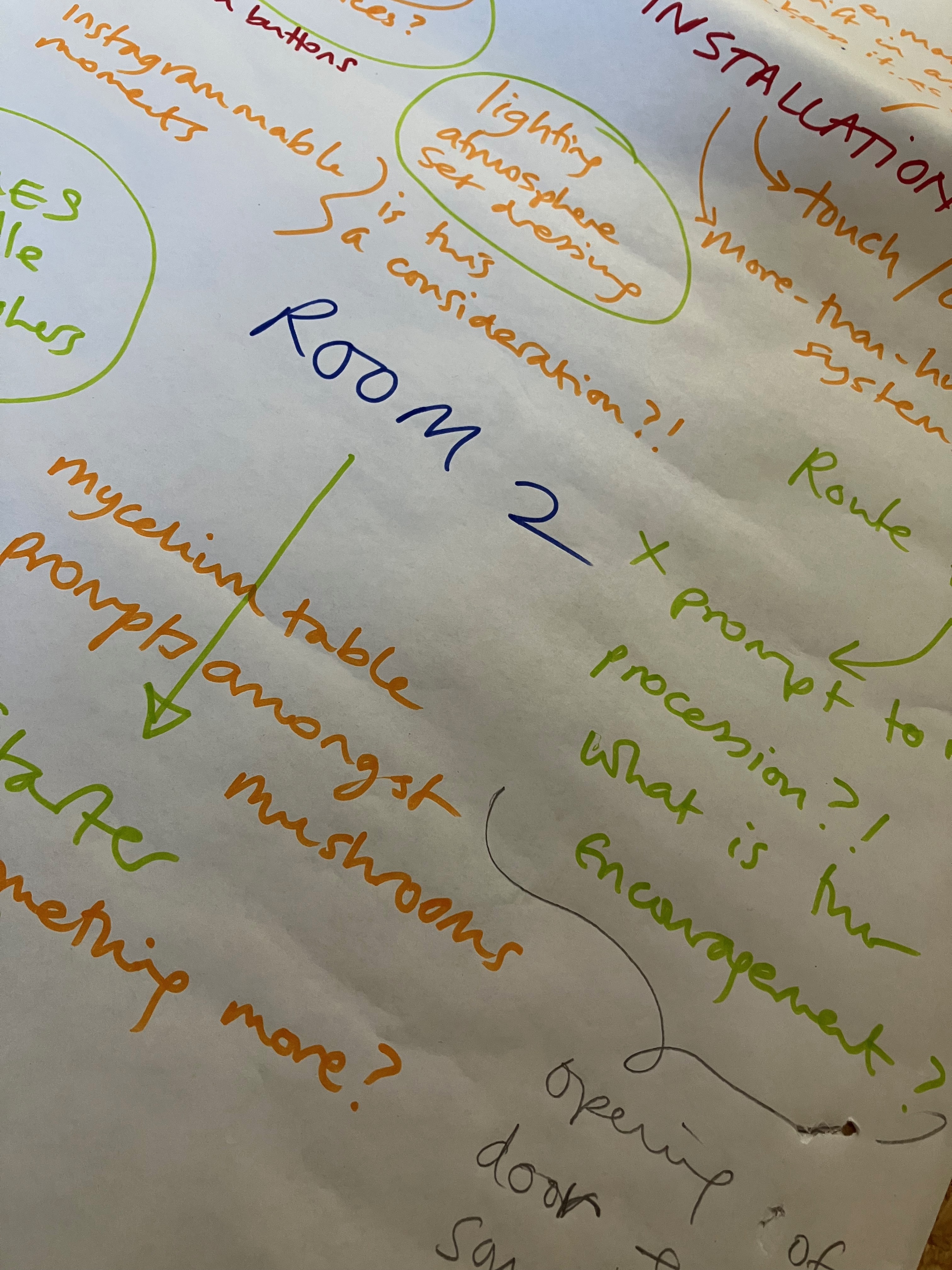












Installation: allowing nature to take over the space





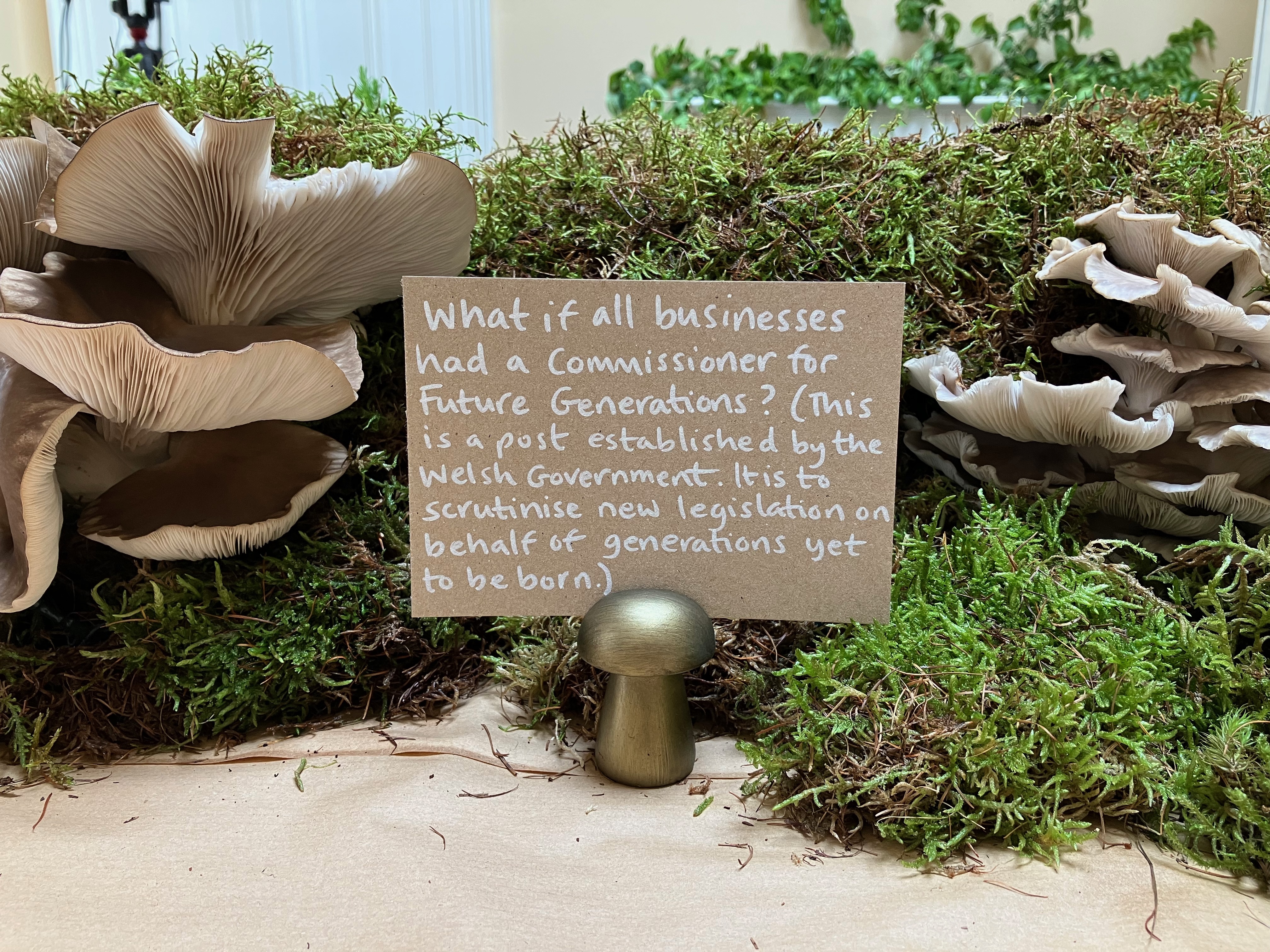

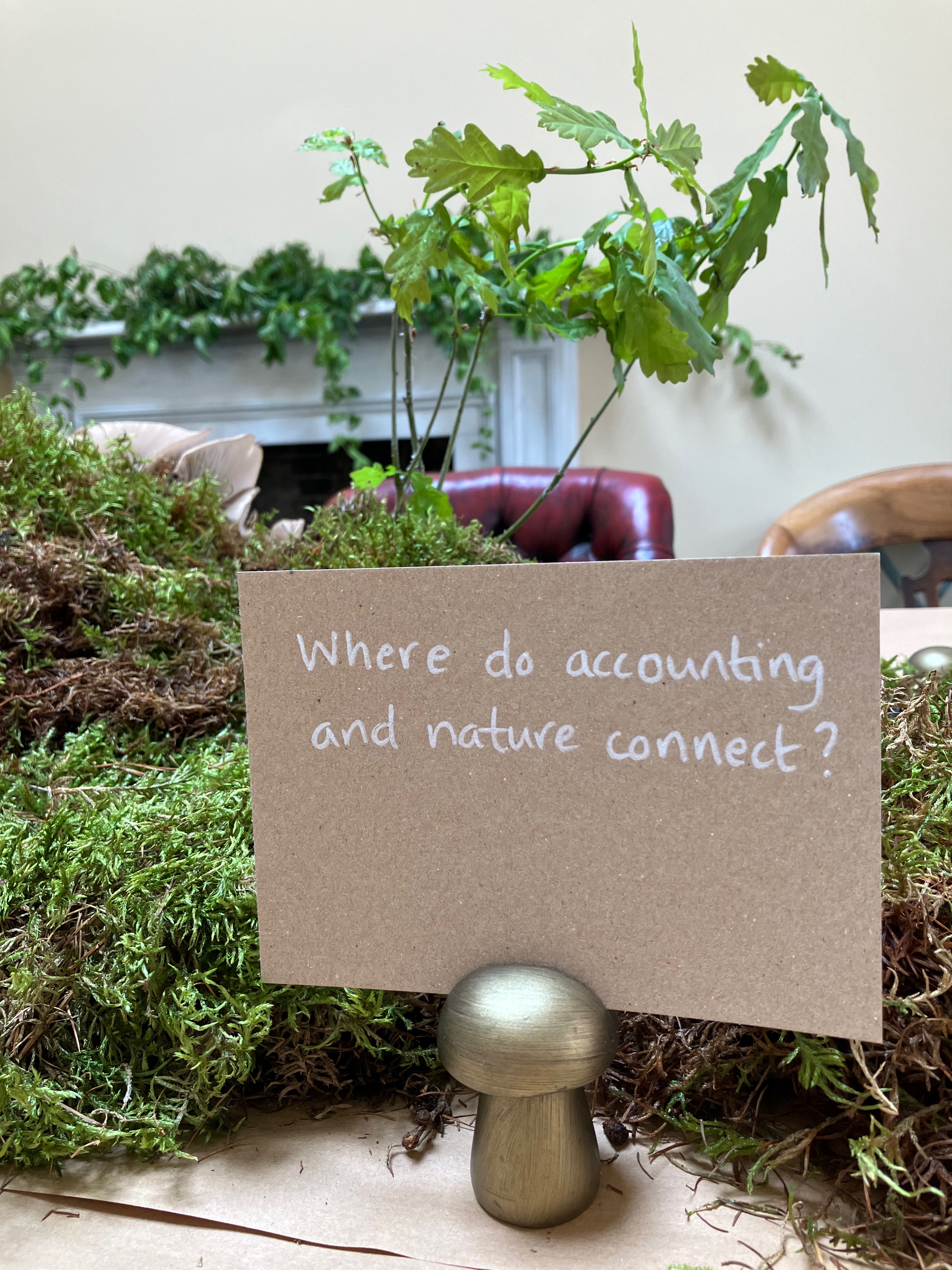





Creative Accounting: art, food & conversation
As the evening began, the Master of Cere-monies welcomed the guests and guided them to the bar, where the Clerk to the Chef served them drinks and canapés. They were then directed into the Tearoom. In a pool of light in the centre of the room was the Book-Keeper of the Mushrooms, who guided the guests to collabrate in making mushroom music, told them stories about how fungi communicate, about mycelial systems… Headphones were then handed out, and the guests listened to ‘The Accountant’ audio story. They were guided into the Reading Room, where dinner was served, and the Master of Cere-monies encouraged them to think about, and discuss, the prompt questions on the cards as they ate.





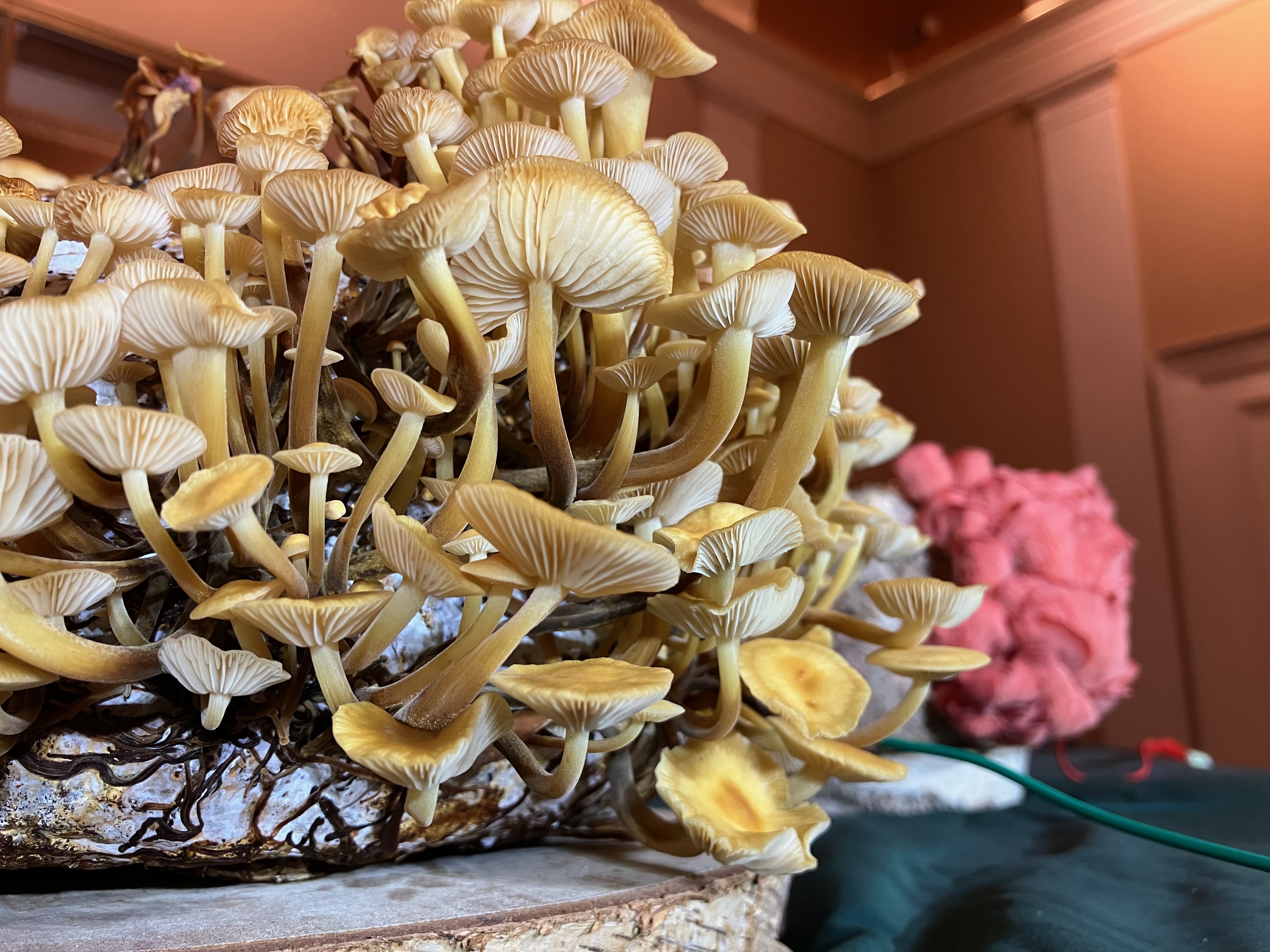
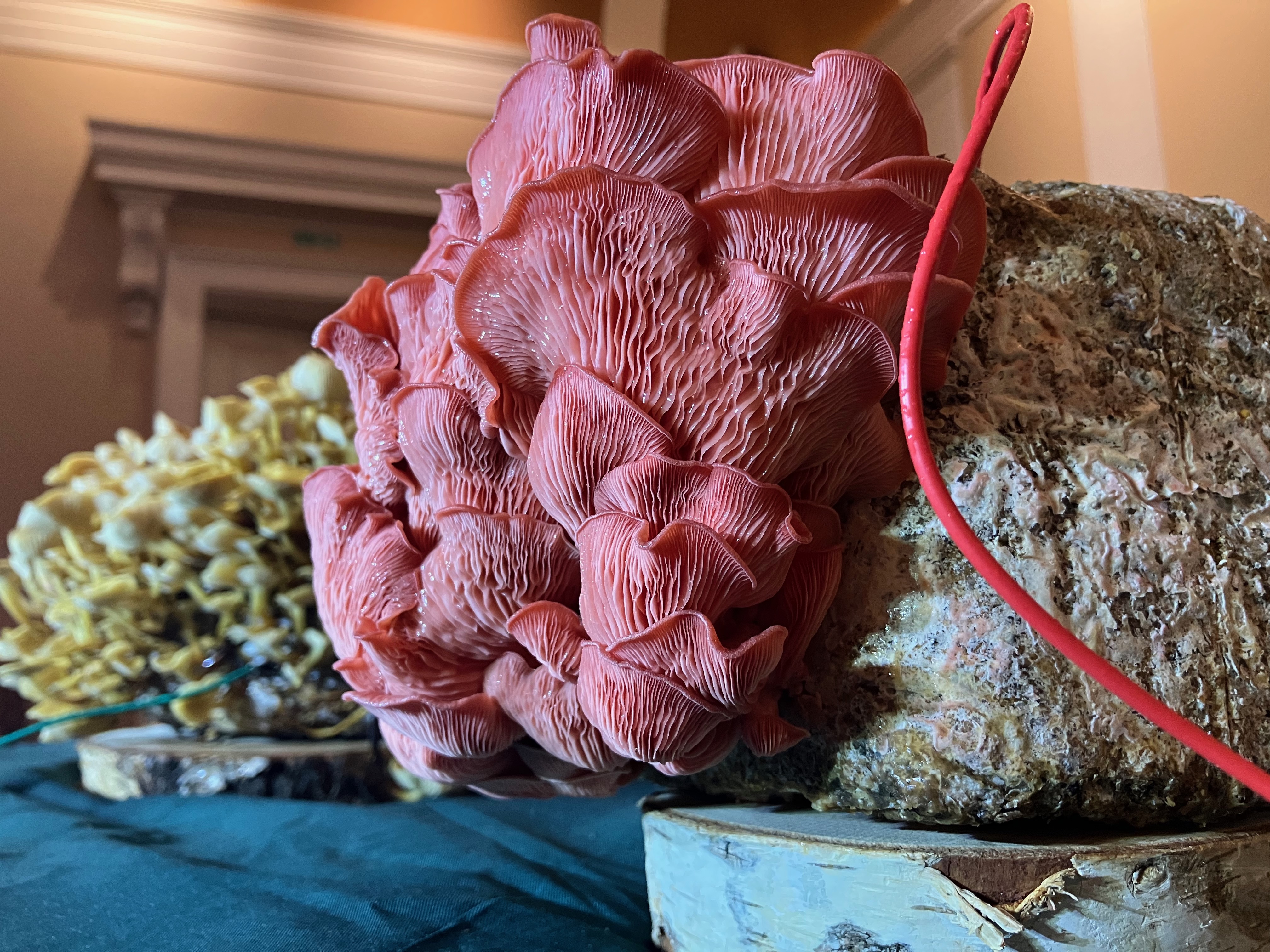



Afterwards: what change might we achieve?
At the end of the meal, the Master of Cere-monies described a close encounter with a sparrowhawk, which had changed him. He asked:
“What change might we achieve if every human could
experience that kind of deeply profound connection with the
more-than-human?
If everyone could bathe in the immensity of the Milky Way;
observe the complexity of a wasps’ nest under construction;
stretch out on the woodland floor and gaze up through the leafy
canopy; wonder at the web of mycelium sending electrical
impulses through the soil; feel a small fish brushing their foot on
its way upstream; or find themselves eye to eye with a wild
creature and experience it looking deep into their soul…”
To close, he asked the guests to reflect on the evening and note down one feeling, one takeaway and one action on the paper tablecloth.





Time will tell whether the evening’s impact lasts and grows, but the initial signs were hopeful. As part of a larger research project, some of this will become clearer through the team’s follow up interviews.
The later reflections, and actions taken, as a result of experiencing something like this are the part that we, as artists, don’t usually get to hear about, or include in a project evaluation. This is because our evaluation has to be done immediately, before the audience leaves the venue, and – often – in order to claim the last part of the grant. The system does not recognise that, in reality, such reflections take much longer than that to percolate – often resurfacing in unexpected ways months or years later.
I hope that the accountants’ busy lives did not crash straight back in on them. I hope moments from the evening have kept returning to them. I hope they are impacted in deeper ways than they might first have thought, and that these impacts inspire action. I hope some of this will happen in a timeframe that can be captured by the research project, and I hope that the actions they are inspired to take will create and inspire further change…if I find anything out about this, I’ll let you know.
Huge thanks to Lisa and Josh for coming on board and making the event a proper TB team effort; to Scott, Alessandro, Nick, Nick and Maureen (the research team) for being so open to our ideas; to Nicola and her staff at Drapers Hall for being up for anything; to Camille for being happy to wear an apron; to the accountants for just going with the flow; to Derek for doing such a fine job on the sound; and to Charlie for (among other things) mopping the floor!
**Moss update – for anyone who was worrying about the moss – it is now colonising new ground in three different Coventry locations, providing homes for another set of insects and a lovely warm, comfy nest lining for at least one clutch of blackbird chicks. The tree seedlings have been planted out around Coventry and the allotment prunings have now been shredded and are on their way to becoming compost. The mushrooms were extremely tasty and fed the team for quite a while – top flavour votes went to the shiitake and lion’s mane.
*When we started work, the menu was already set – although it would have been good to have been able to have had some influence over the food and drink, given there are so many environmental and ethical issues tied up in food production and transport. Although I didn’t manage to get mushrooms on the menu, I did have several conversations with the caterers to satisfy myself that the food served was not undermining the messages we were trying to convey.




One thought on “Accounting for Change”